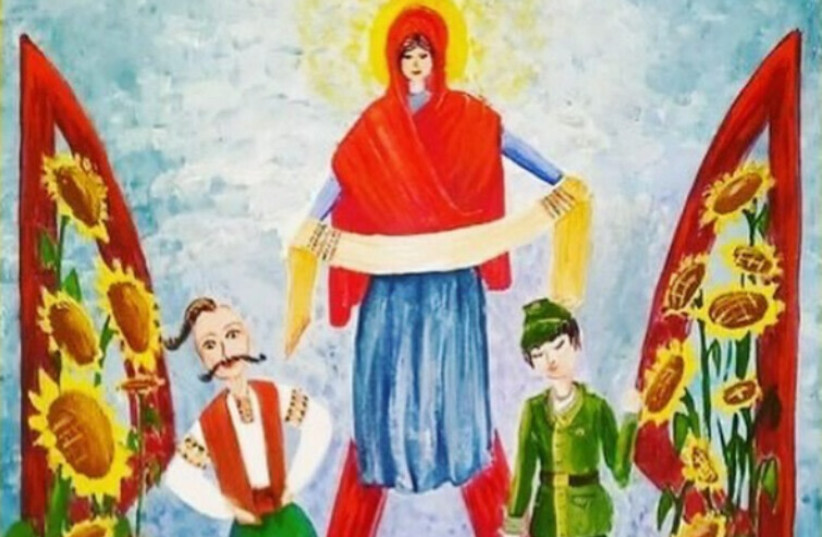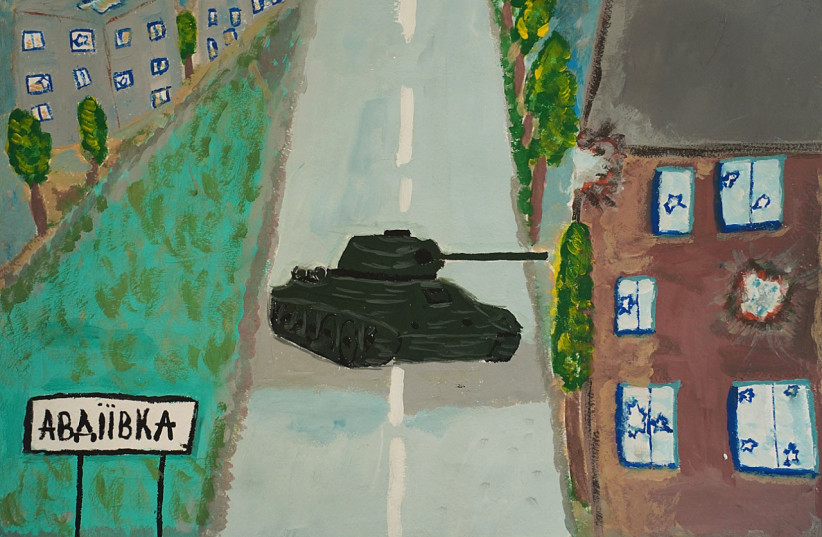Art imitates war. And sometimes, art reflects reality as seen through the eyes of children. They focus on their immediate experiences, what is happening close to them, what they see with their own eyes, and not the general geopolitical situation. This reality will stay with them for the rest of their lives.
For more stories from The Media Line go to themedialine.org
As the first month of the Russian invasion of Ukraine reaches its end, the war starts to leave a heavier mark on the victims’ minds, particularly on the most impressionable minds – those of children.
Marta О. Pyvovarenko, emergencies advocacy officer at the Community Self-Help nongovernmental organization in Lviv, told The Media Line that children perceive war through the eyes of their parents or teachers.
“War for children is a part of their lives, transmitted by adults. Children do not always see war but they hear everything their parents say, and the emotions of their parents greatly affect their minds,” she said.
Pyvovarenko currently heads the psychological component of the Medical Committee to Create a Unified Rehabilitation Standard for Veterans and Their Families, in the Veterans Affairs Ministry, an initiative of the Ukrainian Women's Veteran Movement.
Valeriia Polska, a Ukrainian art therapist focused on trauma and stress response, told The Media Line that she has learned from her experiences that a child’s ability to cope with war depends on several factors, including proximity to actual danger; the parents’ ability to cope with the situation; and the child’s neurological system and general health conditions.
She described drawing as a therapeutic process. “By drawing, we fall into the world of metaphors and sensory experiences. We reconnect with our emotional world and translate it to others,” she said.
While creating art, Polska continued, “our body, mind, and emotions are connected. That’s why drawings and other art techniques are so effective as emotional help. In drawing, children release their complex feelings about past and present.”
Pyvovarenko said, “Some of the drawings clearly show the child’s regression associated with an injury.”
She explained that trauma often forces a child to begin new stages of their development in order to free their psyche from the experience. “Development is a necessity for children, and therefore it is the most common reaction to psychological trauma,” she said.
“Obviously, drawings are diagnostic material for us, they are a way of understanding or rethinking life” for children who have seen war, Pyvovarenko said.
Pyvovarenko noted that Lviv is now a way station for many refugees from eastern Ukraine on their way abroad, and she shared with The Media Line some of the drawings children created during the few days they stay in the shelters where she works with them.

Anastasia, age 9, painted this girl with flowers. She arrived in Lviv last week after fleeing her home in Bucha, in the Kyiv area.
Pyvovarenko, who treated Anastasia during her stay in a shelter, said the girl painted a woman wearing the typical poppy-seed flower crown and dress of Ukrainian culture. In the background, one can see a building being attacked by a missile. In each window, Anastasia painted the number of family members living in each apartment. Pyvovarenko said this is exactly what happened to Anastasia’s home before she left Bucha.
Pyvovarenko explained that Lviv is safer than many places in Ukraine, but it still feels like a warzone. Sirens sound many times a day and people run to the bomb shelters. Her conversation with The Media Line was interrupted by sirens.

Margaryta, 13, painted this. She arrived at the shelter from Koziatyn, in the Vinnytsia region of central Ukraine.
The girl knows about the bombing, and she painted a call to God for protection, Pyvovarenko explained. The “still pure and not injured psyche of the girl is visible from the colors of the drawing,” the art therapist added.
Pyvovarenko also shared drawings done by children from the east (Donbass) who were under Russian occupation and now had to flee to Lviv and abroad. “They are experiencing long-term consequences of psychological trauma. And these neurological, psychological, and behavioral disorders are typical of humanitarian disasters,” she said.

Andriy, 12, an only child from Avdiivka in Donetsk, depicted a tank driving through the city’s streets and aiming its cannon at the windows of an apartment building.
Together with his parents, he lived in the old part of Avdiivka, near the battlefield. It was repeatedly hit by bullets, mortar shells, and Grad missiles. The windows are covered with sandbags.
Andriy’s parents bought the house before the 2014 war by selling apartments in the city center and investing all their savings in it. It was the house of their dreams, with a beautiful garden and a vineyard. At the beginning of the current war, it was 220 yards from the front line with the Russian-backed separatists.
When Andriy was asked to draw how he sees the war, he was excited, Pyvovarenko said. He really wanted the picture to look good because he is an artist. But in the circles where he studied, no one taught how to draw military equipment.
When his mother saw the picture, “she was surprised. He depicted real events that took place five years ago. With the start of hostilities, Andriy’s parents lost their jobs in Donetsk, the company closed. In an effort to make a living, they bought a pig and intended to sell the meat in Avdiivka,” Pyvovarenko said.
But the electricity went off, the refrigerator did not work, and the meat spoiled.
The family was in a store in the city center when heavy shelling began. Andriy was scared and his parents decided to go home. They were driving in Avdiivka, and at the front’s edge, at the checkpoint, they were stopped because a tank was passing by. The tank stopped right in front of their car and began to rotate its turret.
As it turned out, the barrel turned in their direction. Andriy was very frightened and long afterward he was afraid to leave home for the city center. It is possible it was after this incident that the boy began to have a nervous tic.
There were many terrible moments in the family’s life after that, when for months they had to wait out the shelling in the basement of their home, but it was the incident with the tank five years ago that Andriy chose to portray.
For three years now, the boy has been receiving periodic treatment. The result, unfortunately, is still disappointing. Of course, for the treatment to be successful, the traumatic factor must be eliminated. But the war continues. It is not possible to visit a psychologist all the time. The family has nothing and nowhere to go.
Art is a useful tool for conserving children’s mental health, especially in extreme cases such as the Russo-Ukrainian war. It lets them express themselves, organize their thoughts, understand the, and let them out.
We, as adults and therapists, can use these drawings to check the current situation of a child’s mind, Polska said. The child uses it to relieve pain, form a new sense of self, and adapt to new situations.
